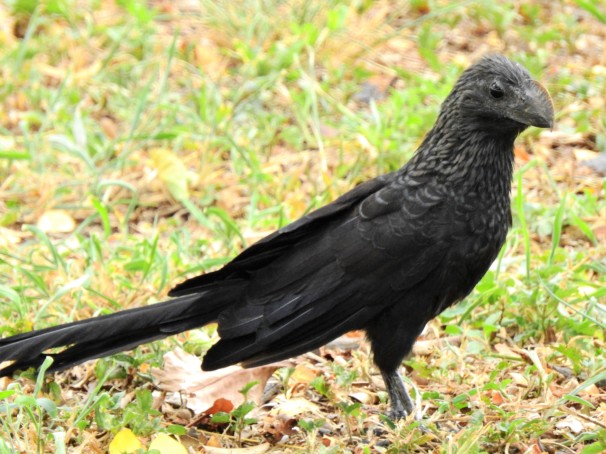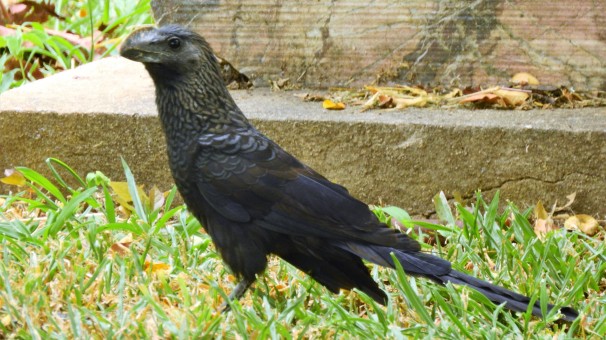The Smooth-billed Ani (Crotophaga ani) is a large near passerine bird in the Cuckoo family. It is larger on average than the Groove-billed Ani but smaller than the Greater Ani. It measures 12–14 inches in length and weighs 2.5–4.7 ounces. The adult is mainly flat black, with a long tail, deep ridged black bill, and a brown iris. It is a resident breeding species from southern Florida, the Bahamas, the Caribbean, parts of Central America, south to western Ecuador, Brazil, and northern Argentina. [Wikipedia]
Smooth-billed Ani Facts [All About Birds]
- Like other Anis, the Smooth-billed Ani lives in small groups of one to five breeding pairs, and up to seventeen individuals. They defend a single territory and lay their eggs in one communal nest. All group members incubate the eggs and care for the young.
- One member of a Smooth-billed Ani group often sits on a high perch and watches for danger while the rest forage.
- Several Smooth-billed Ani females typically lay eggs and incubate in the same nest. Late-laying females bury the eggs of early-laying females with twigs and leaves, which can create a number of layers of eggs; only the top layer eventually hatches. As many as 36 eggs may be found in a single nest.
- Juvenile Smooth-billed Anis from first broods stay with their natal group and help feed the second brood.









A lost looks like a descendant of dinisaurs, or dragons? ; )
LikeLiked by 1 person
I thought the same thing. 🙂
LikeLike
My thought as well. Definitely has a prehistoric look about it.
LikeLiked by 1 person
Dinosaurs
LikeLike
We see alot of these especially when grass is just cut…
LikeLiked by 1 person
Yea? Where is this?
LikeLiked by 1 person
Trinidad & Tobago…
LikeLiked by 2 people
Ok, now I understand.
LikeLike
We have them in our yard in Kingston, Jamaica almost daily. Yes, they love pottering around on the ground digging stuff up. They also love our bird bath, and often sit around the edge with their long tails soaking in the water! I have taken numerous photos – I love them, and affectionately call them “my uglies”! They are unusual birds in that they don’t have any “personal space,” so often sit really close together.
LikeLiked by 1 person
I spotted them at Hope Gardens. It was my first time seeing them. At first I thought they were crows, but after a closer look I realized they were far more interesting.
LikeLike
Wow, what a beak! I’ve never seen this bird before, thank you for sharing!
LikeLiked by 1 person
It was my first time seeing it too. Thank you for visiting my page and commenting.
LikeLiked by 1 person